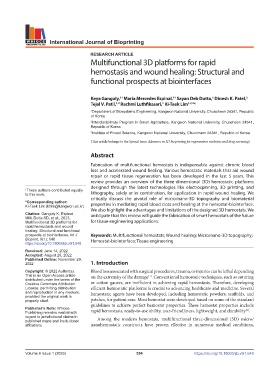Page 362 - IJB-9-1
P. 362
International Journal of Bioprinting
RESEARCH ARTICLE
Multifunctional 3D platforms for rapid
hemostasis and wound healing: Structural and
functional prospects at biointerfaces
Keya Ganguly, Maria Mercedes Espinal, Sayan Deb Dutta, Dinesh K. Patel,
1
3
1†
1†
Tejal V. Patil, Rachmi Luthfikasari, Ki-Taek Lim 1,2,3 *
1
1,2
1 Department of Biosystems Engineering, Kangwon National University, Chuncheon 24341, Republic
of Korea
2 Interdisciplinary Program in Smart Agriculture, Kangwon National University, Chuncheon 24341,
Republic of Korea
3
Institute of Forest Science, Kangwon National University, Chuncheon 24341, Republic of Korea
(This article belongs to the Special Issue: Advances in 3D bioprinting for regenerative medicine and drug screening)
Abstract
Fabrication of multifunctional hemostats is indispensable against chronic blood
loss and accelerated wound healing. Various hemostatic materials that aid wound
repair or rapid tissue regeneration has been developed in the last 5 years. This
review provides an overview of the three-dimensional (3D) hemostatic platforms
designed through the latest technologies like electrospinning, 3D printing, and
† These authors contributed equally
to this work. lithography, solely or in combination, for application in rapid wound healing. We
critically discuss the pivotal role of micro/nano-3D topography and biomaterial
*Corresponding author: properties in mediating rapid blood clots and healing at the hemostat-biointerface.
Ki-Taek Lim (ktlim@kangwon.ac.kr)
We also highlight the advantages and limitations of the designed 3D hemostats. We
Citation: Ganguly K, Espinal anticipate that this review will guide the fabrication of smart hemostats of the future
MM, Dutta SD, et al., 2023,
Multifunctional 3D platforms for for tissue engineering applications.
rapid hemostasis and wound
healing: Structural and functional
prospects at biointerfaces. Int J Keywords: Multifunctional hemostats; Wound healing; Micro/nano-3D topography;
Bioprint, 9(1): 648 Hemostat-biointerface; Tissue engineering
https://doi.org/10.18063/ijb.v9i1.648
Received: June 14, 2022
Accepted: August 29, 2022
Published Online: November 29,
2022 1. Introduction
Copyright: © 2022 Author(s). Blood loss associated with surgical procedures, trauma, or injuries can be lethal depending
This is an Open Access article on the extremity of the damage . Conventional hemostatic techniques, such as suturing
[1]
distributed under the terms of the
Creative Commons Attribution or cotton gauzes, are inefficient in achieving rapid hemostasis. Therefore, developing
License, permitting distribution efficient hemostatic platforms is crucial to advancing healthcare and medicine. Several
and reproduction in any medium, hemostatic agents have been developed, including hemostatic powders, scaffolds, and
provided the original work is
properly cited. patches, for patient care. Most hemostat were developed based on some of the standard
guidelines to achieve perfect hemostat properties. These hemostat properties include
Publisher’s Note: Whioce [2]
Publishing remains neutral with rapid hemostasis, ready-to-use ability, user-friendliness, lightweight, and durability .
regard to jurisdictional claims in Among the modern hemostats, multifunctional three-dimensional (3D) micro/
published maps and institutional
affiliations. nanohemostatic constructs have proven effective in numerous medical conditions,
Volume 9 Issue 1 (2023) 354 https://doi.org/10.18063/ijb.v9i1.648

